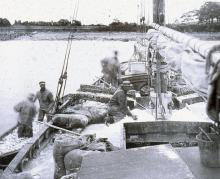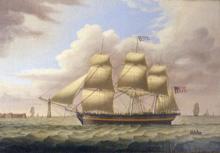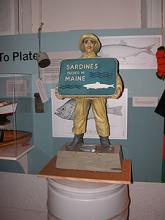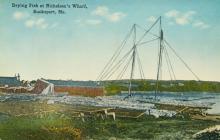Processing and Preserving Fish
In the days of the schoonersSchooner
A sailing vessel of two or more masts, all fore-and-aft rigged. The Thomas W. Lawson, built in 1902, had seven masts. In comparison to a square-rigged vessel of comparable tonnage, a schooner is better for coastwise sailing., offshoreOffshore
In fisheries, fishing conducted further than 3 miles from land. These generally require larger vessels for overnight passages and work. fishermen processed their catch aboard their vessel. The fish’s head was cut off, and it was split longitudinally down the belly side. The entrailsEntrails
Internal organs or intestines., called gurryGurry
Fish offal or waste including skin, fins and guts; a term extended to include garbage on board fishing vessels., were removed, and the cod’s liver was saved for cod liver oilCod liver oil
Oil made from the liver of cod. It is one of the best sources of Vitamin A and D.. The backbone was removed, the fish was washed in salt water, and then stored below deck in salt. Salting the fish was left to experienced fishermen, who knew just the right amount to use.
A large schooner might take with it 150 hogsheadsHogshead
Cask or barrel for liquids containing from 54 to 63 gallons, depending on the type of liquid. About the size of today's 55 gallon drum. (about 560 pounds each) of salt for a season’s fishing. Salt was the most expensive purchase made for a voyage, and had to be imported.
Castine specialized in the salt trade in the early 19th century. The St. Leon, owned in Castine, often carried salt which was then sold around the Bay.
After the schooner returned home, the fish was rinsed and salted again, then laid out to dry on wooden slats called flakesFlakes
Wooden racks on which fish were laid out to dry in the sun.. The product was called salt dried codSalt dried cod
Cod that is cleaned, split or filleted, salted with a heavy layer of salt rubbed into the fish, then sun dried.. Some herringHerring
Perhaps the world's most important food fish; there are sixteen species, with the Atlantic herring the dominent North Atlantic species. Fished heavily for centuries, today herring is caught in Maine waters primarily for lobster bait with some going to sardines. With new fishing technology there are serious concerns about overfishing. was used fresh for bait, and some was salted. Both herring and mackerelMackerel
Atlantic mackerel is the species found in the North Atlantic. A schooling, bony, oily, strongly-flavored food fish, green above with dark blue bars and silvery color below. The commercial stock has rebounded since near collapse in the 1970s. Without ice they spoil quickly. They are caught in purse seines which produce relatively little bycatch and no bottom damage. Today most of Maine's mackerel fishery is recreational. were also pickledPickled
Pickling is the process of preserving food by soaking and storing it in brine (highly salted water) or vinegar. in barrels. In the second half of the nineteenth century, Maine became a world leader in canning small herring with oil or sauces to create sardinesSardines
Small herring, preserved in oil or sauces and canned. Maine had many sardine factories.. Starting from one cannery in 1875, by 1908, 33 canneries produced sardines. Most were in Washington County; Penobscot Bay had four.
Many of these also canned clamsClam
A shelled mollusk of which there are a number of species. It has a relatively symmetrical oval shell. The dominant Maine clams are soft shelled and live in the mud in the intertidal zone.. At the same time there were 86 companies that produced smoked herring and other fish. More people worked in fish processing than in fishing.
By the mid-twentieth century factory shipsFactory ship
In fishing, a large ship that takes in the catch from smaller ships for processing or preservation at sea. processed groundfishGround fish Groundfish
Bottom-dwelling fish, especially commercially-valuable ones such as cod or flounder. for frozen fish filletsFillet
In fishing, the narrow strip of boneless meat from either side of a fish's spine., using special machinery designed to cut fillets before the fish was flash frozenFlash freeze
Quickly freezing fish or meat to preserve the natural juices and flavors of the flesh..
Clams, musselsMussel
A bivalve mollusk with numbers of species found in both fresh and salt water. Of commercial interest in Maine is the blue mussel, found in natural mussel beds and raised in aquaculture., crabsCrab Rock crab, Green Crab
Crabs are often found in lobster traps. The Rock Crab is Maine's native crab, up to 6 inches shell size while the smaller Green Crab is an invasive Northern European species which had spread all along the Maine coast by 1953.
Read More, lobstersLobster Homarus americanus
An edible crustacean, Homarus americanus refers to the species found in the North Atlantic., and oystersOyster
Oysters are a bivalve mollusk of great commercial value. Disease and overfishing have decimated once thriving beds in the Chesapeake Bay, New York Harbor and Long Island Sound. Maine's waters have never had a commercial oyster fishery due to slow growth compared to areas south of Cape Cod. There are some oyster farms that are now seeking to provide oyster brood stock. need little processing before they are eaten, as long as they are fresh. ScallopsScallop
Scallops are bivalve mollusks which differ from clams and mussels by being active free swimmers. They have symmetric fluted shells. They are caught with dredges. Maine's fishery became commercially viable around 1900 with the introduction of the gasoline engine. are normally split open and the meats cut out before the fishing vessel returns to dock.
Most seafood today is sold fresh, frozen, smoked, or canned, and only a small percentage is cured and dried in salt, or pickled. Air transportation, hermetically-sealed containers, and refrigerated vehicles make it possible for people to have fresh fish almost anywhere.
Maine now supplies the Far East with sushi-quality tunaTuna
Fast swimming migratory ocean fish of tremendous commercial importance. Capture is now regulated by the National Marine Fisheries Service. Appear in the Gulf of Maine in summer where there is a recreational fishery., sea urchinSea urchin
Echinoderm with a spine covered shell; feeds on algae. Roe is prized as a delicacy in the Far East. In 1987, a market for Maine sea urchins was developed in Japan triggering a sea urchin rush that severely depleted the resource. It is now tightly controlled but it is difficult to reestablish. roeRoe
Eggs of a fish, or egg mass of crustaceans such as lobster., elversElvers
Young eels returning to fresh water where they will live as adults before going to sea again to spawn., and other delicacies. And Maine now imports fish from Canada, Northern Europe, Southeast Asia, South America, and other parts of the world.





